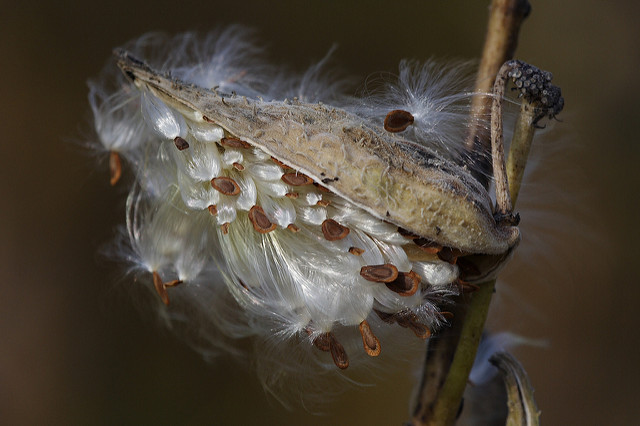By Chelsea Jandreau, Nature Educator
It feels odd to think about spring as we come upon the fall equinox, but plants are preparing for colder weather. Many of them are also preparing for the following spring as well. Many people purchase seeds for summer gardening in early spring or, for those with full vegetable or fruit gardening in mind, even mid-winter. However, wild trees, shrubs and grasses do not have a handy seed catalog to order their seeds from. There are some plants that will produce seeds in the spring and summer, spread and grow, then wait for the following spring to grow and spread again. However, many others take a different route and instead, produce their seeds in the fall. These seeds are prepared to lie dormant for months until the weather cycles back into a season of growth.
Growing up, I remember when the dogs would come in with round, spiky orbs attached to their fur after running around in the yard and woods outside. I’m sure plenty of others have also had the absolute joy of attempting to remove Burdock from a pet’s fur, your own clothing or worse, someone’s hair. Burdock is a fairly innocuous looking plant during the summer, but, as we head into fall, the purple flowers fade and the plant is left with a brown burr filled with mature seeds. These barbed seed packets remain on the stem throughout the winter unless they hitch a ride with a fuzzy organism or fall off due to some other feat of nature.
The prevailing story is that modern day velcro was actually inspired by Burdock. If you look very closely and examine the tiny curved ends of each barb, it does look exactly like the rough side of the velcro patch. Both are basically a mass of tiny hooks that can catch on fuzzier material and stick together.

Burdock was my first exposure to those seeds with sticking power, but this is a common methodology. In Wisconsin, I took groups of students into the woods to explore and play. Throughout the fall and into winter, the students would come out of the forest covered in tiny, spiky seeds stuck into their pants and shirt. Sometimes they were the two-pronged, flat coreopsis seeds and other times there were entire stems of green Virginia Stickseed attached to shoelaces and pant legs.
In the Sierra Nevada mountains of California, there were fields of grasses my groups of sixth graders would walk through as they explored their natural world. Same story, different plant. This time it was hedge parsley and they were inevitable. We called them hitchhikers, because these seeds hitch a ride with whomever is walking by so they can be dropped off somewhere else down the line.
From an ecological standpoint, this seed dispersal mechanism is an effective plan for the grasses and shrubs that employ it. The seeds simply have to wait for something fuzzy or furry to amble by, hook on to the animal or person, and then the moving party does all of the work. It’s an easy way to spread your seeds. It is far more of a nuisance from the other party’s end to pull those tiny, barbed spikes out of fur, hair or clothes. Many plants with these types of seeds are prepared to be patient. They can survive a cold, snowy winter and wait until the following spring to germinate.
Not all fall seeds are catching rides on our clothes, pets, or the fur of wild animals. Some of them are falling from the trees or being eaten as part of the late summer and early fall fruits. Others are carefully being cached away underground as a food source for the winter months.
In September, maple seed helicopters and milkweed fluff are taken along with the wind. Squirrels, chipmunks and other animals industriously gather nuts such as acorns and chestnuts to store for the colder months ahead. While many of these will be eaten, occasionally some get left behind and, if the conditions are right, might start sending out roots next spring.
Pinecones hold multiple delicate seeds hidden under their scales. Once the weather warms up and conditions are more favorable for plant growth, the cones will open up and release their seeds for a chance to germinate.
I think of spring as a time of growth and anticipation, but in order for all of those glorious spring colors and bright green new leaves to continue making our spring days brighter, the plants have to put in some work and preparation in advance. These plants that spread their seeds in the fall and winter are patient. They exemplify the mentality of good things that come to those who wait. I don’t know that this is always true in our human world, or even in other aspects of nature, but it seems to work for many of those little seeds that are currently finding a winter home and patiently waiting until next spring to get the chance to sprout and grow.
Audubon Community Nature Center builds and nurtures connections between people and nature. ACNC is located just east of Route 62 between Warren and Jamestown. The trails are open from dawn to dusk and birds of prey can be viewed anytime the trails are open. The Nature Center is open from 10 a.m. until 4:30 p.m. daily except Sunday when it opens at 1 p.m. More information can be found online at auduboncnc.org or by calling (716) 569-2345.
To learn more about Seed Dispersal, check out these links:
Burdock and Velcro: https://www.loc.gov/everyday-mysteries/technology/item/who-came-up-with-the-idea-for-velcro/
Fall Seed Dispersal: https://www.almanac.com/seed-dispersal


Recent Comments